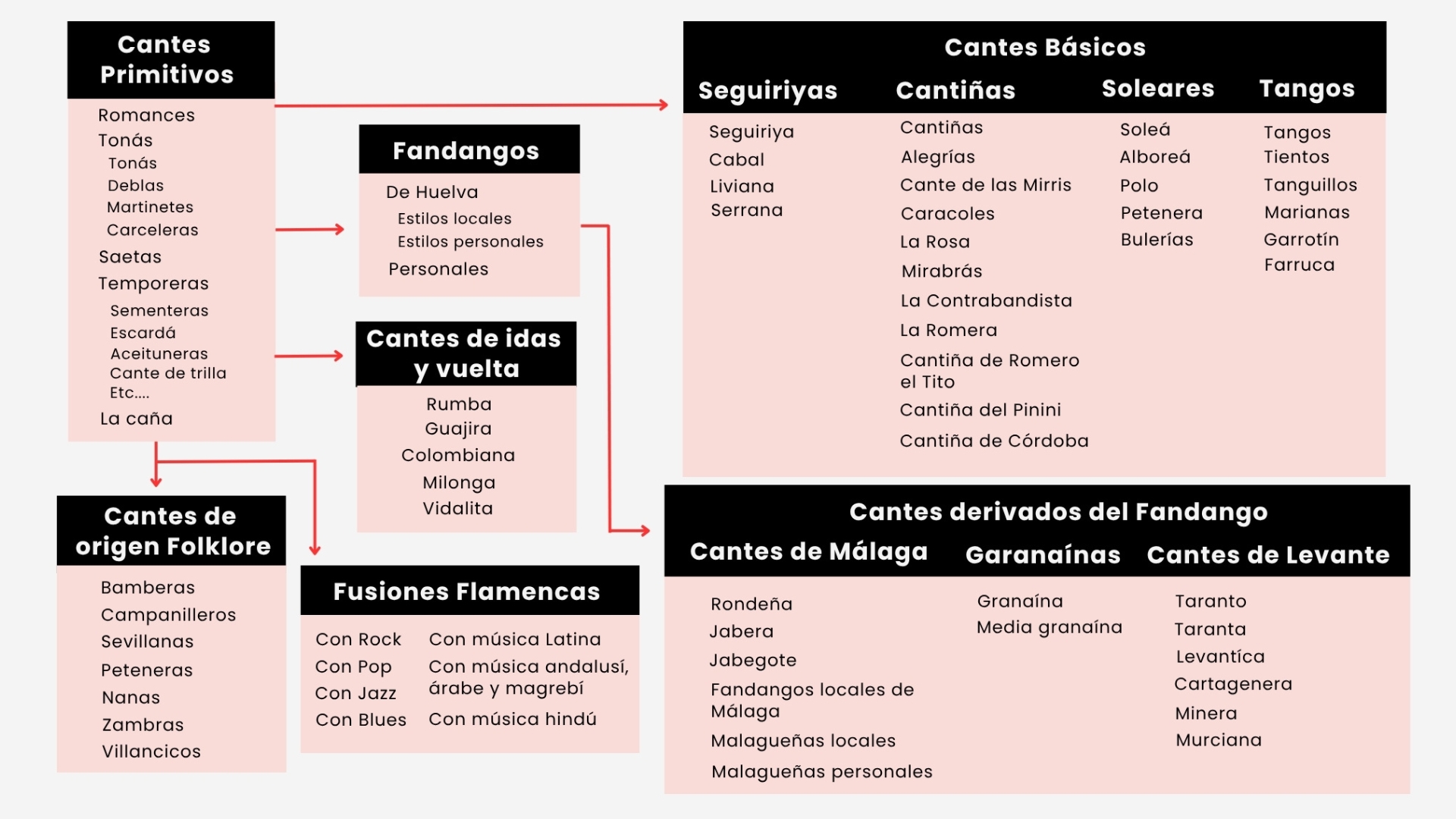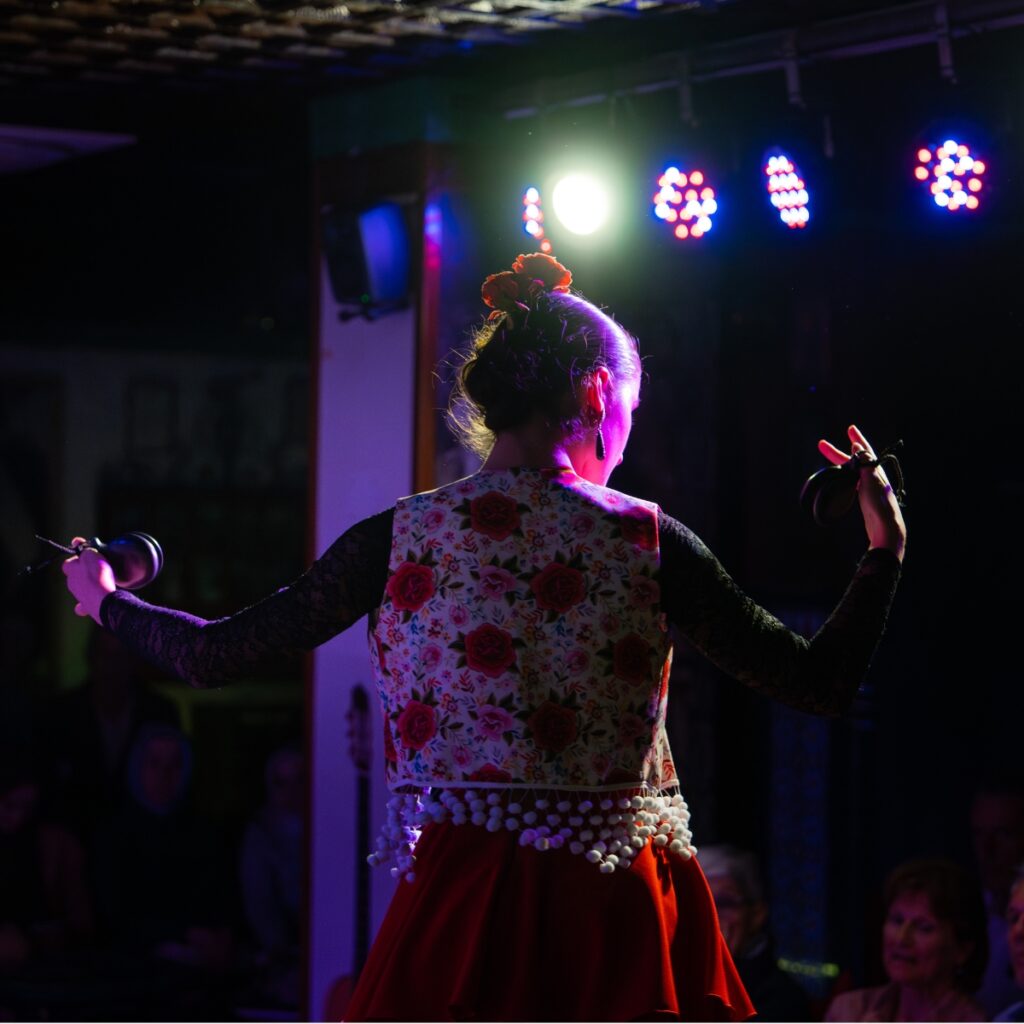Flamenco is an artistic expression that encompasses a great diversity of styles. It is important to keep in mind that flamenco is much more than a musical style, since it is a way of life, a manifestation of feelings such as joy, pain, lament, pride, or love.
At its root, we find the well-known ancient flamenco songs, also called primitive songs or trunks of flamenco, and from these were born the other styles that are known.
In this post, we have tried to create a complete outline of the ancient flamenco songs, although it is complex to outline due to the richness, diversity, and constant evolution of this art. With this outline, it is easier to better understand the roots of flamenco and its subsequent stylistic development over time.
What are the Ancient Flamenco Songs?
The ancient flamenco songs are the predecessor songs of this artistic expression that emerged in Andalusia during the 18th and 19th centuries. It could be said that they are the expressive and emotional basis of flamenco and were transmitted generation after generation orally, that is, the different generations learned them by listening to them. There were no written records or scores.
Normally, these ancient songs reflect the life, suffering, and culture of the Andalusian people, especially the Gypsy people. The most iconic thing about flamenco is that it is a mixture of diverse cultures such as Moorish, Sephardic, and Castilian.
These songs did not have instrumental accompaniment or dance, as they were pure, very emotional vocal expressions.
Therefore, we can say that the ancient flamenco songs are characterized by:
- Not having musical accompaniment in its origins (such as guitars).
- Short, direct, and simple lyrics but with a great emotional charge.
- Austere aesthetic, based on emotion and rhythm (compás), not on adornment.
Types of Ancient Flamenco Songs
Romances
They are one of the most ancient forms of flamenco song. They derive from traditional Castilian romances, transmitted orally for centuries.
They preserve narrative structures and are considered precursors of many later flamenco styles.
Tonás
Together with the martinetes and carceleras, they are part of the group of songs without guitar (a palo seco). They are deeply jondo and are associated with intimate environments, often related to
Saetas
Religious songs that are performed, above all, during the Andalusian Holy Week. Although they have popular roots, the flamenco saeta adopted a freer and more emotional form, close to the jonda aesthetic, influenced by primitive flamenco styles.
Temporeras
They are linked to field work, especially the seasonal olive and grape harvests. They were sung spontaneously during working days, and although not as well known as other styles, they have a strong ethnographic and musical value.
La Caña
Considered one of the oldest styles of flamenco song, it mixes melodic and rhythmic elements that have influenced the creation of other flamenco palos.
Its structure is related to the soleá and the seguiriya, but it has unique characteristics.

Derivations and Evolution
From these primitive songs, other more structured and defined flamenco styles were developed, some with guitar accompaniment and adapted to dance.
Flamenco song evolved thanks to cultural mixing, the influence of other popular music, and the creativity of the performers over time.
The derived songs maintain echoes of their primitive origin, but also introduce melodic, rhythmic, and thematic novelties.
The soleá, the seguiriya, the petenera, the tientos, and many regional styles such as fandangos, malagueñas, or cantes de ida y vuelta, have their initial seed in these primitive songs.
From the primitive songs—such as romances, tonás, saetas, temporeras, and la caña—, flamenco grew and diversified, giving rise to a great variety of styles that reflect different influences, social contexts, geographical regions, and even historical eras.
These primitive songs laid the expressive, melodic, and structural bases on which the entire building of flamenco song was built.
From them we can highlight several evolutionary lines that have given rise to different groups of songs, which are traditionally classified as follows:
Basic or Trunk Songs
The basic songs, also known as trunks of flamenco, are those that establish the fundamental structures of cante jondo. They derive directly from the primitive songs and possess a great expressive depth.
Among them, the following stand out:
Soleares
One of the most characteristic styles of flamenco. With a solemn rhythm and a 12-beat compás, it represents the essence of cante jondo. Its structure has influenced numerous later palos.
Seguiriyas
Considered the most tragic and profound cante of flamenco. Its origin is found in the tonás and martinetes, and its expressiveness reaches very intense levels, transmitting pain, loss, and fatalism.
Cantiñas
Cheerful and rhythmic, they are typical of Cádiz. Although with a more festive character than the soleares and seguiriyas, they also derive from primitive forms and have preserved a great melodic richness.
Tangos
With a binary compás and rhythmic character, flamenco tangos have an uncertain origin, but show ancient roots, possibly African or American, and their evolution has been constant. They are the basis of other more modern styles such as rumbas and bulerías.
Fandangos and Their Regional Derivatives
Another large group of songs arises from the fandango, a musical form widely spread throughout Andalusia that was flamenquized over time. The fandango de Huelva stands out, although many regional styles derive from it, among which the following stand out:
Cantares De Málaga
Such as malagueñas and verdiales, with free and ornate melodies. They reflect the musical tradition of this region and have been adapted by great cantaores.
Granaínas
Of great melodic beauty and lyricism, they are free songs that stand out for their vocal difficulty. They have roots in Granadan folklore, flamenquized in the 19th century.
Cantes De Levante
Such as the taranta, the minera, or the cartagenera. They originate in the mining areas of Murcia and Almería, and transmit the hard work of the miner and life in those environments.
Cantes de ida y vuelta
With emigration and cultural exchanges between Spain and America, the cantes de ida y vuelta arose, which incorporate rhythms and structures of American music adapted to the flamenco language:
Flamenco Rumbas
They derive from Afro-Caribbean rhythms, such as the guaracha and the Cuban rumba. They were adapted to flamenco with lyrics in Spanish and a more festive style, popularized in the 20th century.
Other styles such as guajira, milonga, and vidalita are also part of this group, which, although less popular than the rumba, show the richness of the mixing between Andalusian songs and overseas music.
Songs of Folkloric Origin
Some flamenco styles have their origin in traditional and popular forms of Andalusian and Spanish folklore, which were later flamenquized:
Sevillanas
Although not considered a cante jondo, sevillanas are one of the best-known styles of the popular repertoire. They come from ancient Castilian seguidillas and were adapted to the Andalusian style.
Zambras
Of Moorish and Gypsy origin, they are songs associated with dance, especially in the Sacromonte of Granada. It combines music, dance, and ritual.
Peteneras
Melancholy style of great emotional intensity. Its origin is uncertain, but some link it to Sephardic traditions. It has been reinterpreted in flamenco with great expressiveness.
We can also include bamberas, campanilleros, villancicos, lullabies, etc.
Contemporary Flamenco Fusions
In recent decades, flamenco has continued to evolve and has come into contact with other contemporary musical genres.
These flamenco fusions have contributed to expanding its international reach and creating new forms of expression:
Flamenco and Pop
Artists such as Rosario, Niña Pastori, and El Barrio have mixed flamenco with pop structures and harmonies, making it more accessible to new audiences.
Flamenco and Rock
Since the 70s, with groups such as Triana or Medina Azahara, electric guitars and progressive rock sounds were incorporated into the flamenco universe.
Flamenco and Jazz, Flamenco Chill, Electronic Flamenco
These fusions have given rise to innovative proposals where improvisation, rhythm, and sound experimentation merge with the forms of traditional flamenco.
Flamenco is a living art, in constant transformation, but it never loses contact with its roots.
From the primitive songs to the most modern forms, the entire flamenco universe continues to revolve around the same essence: the sincere expression of human emotions through song, toque, and dance.

